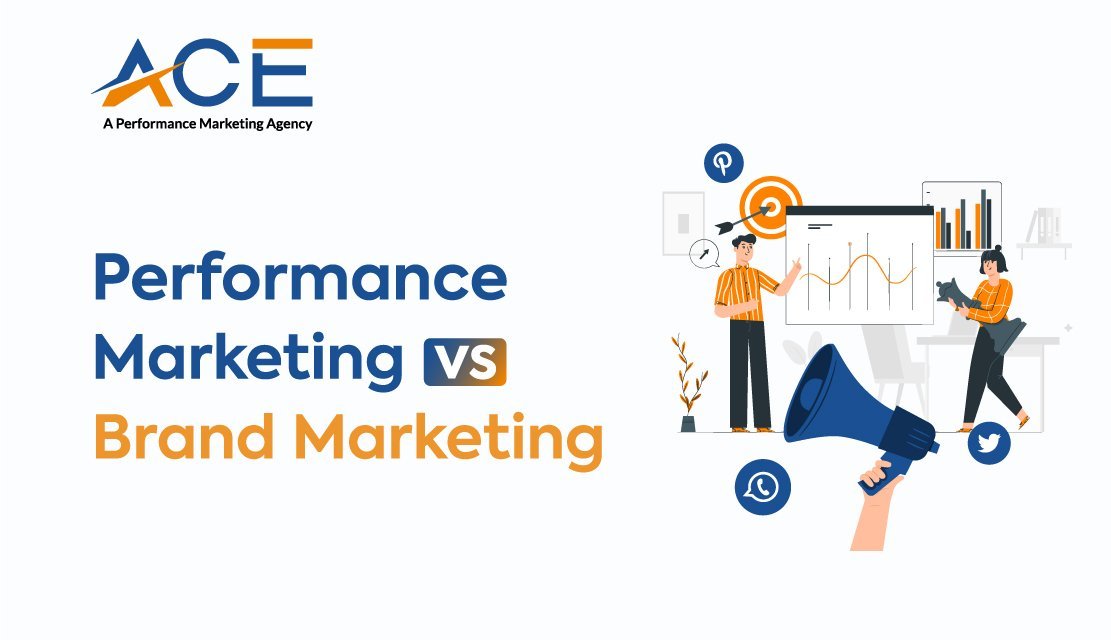In the fast-paced world of marketing, choosing the right strategy is crucial for your business’s success.
Two distinct approaches have gained prominence over the years: Performance Marketing and Brand Marketing.
While both have their merits, it is essential to understand the differences, benefits and when to use each.
In this blog, we will take a closer look at performance vs brand marketing, their unique characteristics and why a balanced approach, like the one we offer at ACE Performance Marketing, can be an effective way to achieve short-term gains and long-term brand growth.
Performance Marketing: An In-Depth View
Performance marketing is a results-oriented strategy that generates measurable outcomes. This approach relies on a data-driven methodology to engage with potential customers and drive sales, primarily through various digital channels.
Here are some key components of performance marketing:
Pay-Per-Click (PPC) Advertising:
This channel gives marketers the opportunity to display ads and pay only when a user clicks on them. It is a cost-effective way to drive traffic and conversions.
Social Media Marketing:
Leveraging the power of social platforms like Facebook, Instagram and Twitter, performance marketing aims to reach the right audience with targeted ads, ensuring your message is delivered to those most likely to convert.
Influencer Marketing:
When it comes to performance marketing, collaborating with influencers can be a game-changer. By teaming up with individuals who have a strong online presence, brands can tap into their followers to boost sales.
Email Marketing:
Performance marketers use email campaigns to engage with potential customers, delivering tailored content to their inboxes. The effectiveness of different email variants can be tested to optimize results.
Ad Retargeting:
This technique involves showing ads to individuals who have previously interacted with your brand. By retargeting, you can remind potential customers of your products or services, encouraging them to complete a purchase.
Search Engine Optimization (SEO):
SEO is crucial for ensuring your website ranks well in search engine results. This increases your online visibility and drives organic traffic, which can lead to sales.
Performance marketing provides instant, trackable results. It equips marketers with the tools and insights they need to optimize their campaigns and achieve better outcomes.
For example, during an email marketing campaign, performance marketers can conduct split testing to determine which content resonates most with the audience, thus enhancing the campaign’s effectiveness.
Brand Marketing Defined
On the other hand, Brand Marketing focuses on building long-lasting relationships between companies and customers. The main objective is to create a strong brand identity, build trust and establish emotional connections.
Brand marketing activities can include consistent branding across all channels, releasing customer-focused apps and building relationships through social media and traditional advertising.
Brand marketing can be challenging to measure directly in terms of its impact on business success.
For example, using a catchy jingle in an ad may improve brand recognition without immediately boosting sales, but it can contribute to higher revenues over time.
Performance vs Brand Marketing
To understand the difference between brand and performance marketing, we need to break it down:
Brand Marketing: Creating a Strong Brand Identity
- Business Goals:
One of the primary goals of Brand Marketing is to capture market share and secure future cash flow. It represents an investment that aims to establish a strong presence in the market, making your brand a trusted choice among consumers.
- Marketing and Sales Impact:
Brand Marketing aims to build brand equity, which translates into increased demand for your products or services in the long run. By developing trust and creating a bond with your audience, this strategy sets the stage for future sales.
- Short-term or Long-term:
Brand Marketing is a long-term strategy that spans multiple years. It is not about quick wins but about nurturing your brand’s identity over time, ensuring it becomes a household name.
- Messaging:
The messaging in Brand Marketing is emotional and revolves around brand positioning. It seeks to touch the hearts of your audience, making them feel connected to your brand and what it represents.
- Targeting:
In Brand Marketing, the focus is on mass targeting the total addressable market. This means reaching out to a broad audience, not just those who are ready to make an immediate purchase.
Performance Marketing: Driving Immediate Results
- Business Goals:
The main objective of Performance Marketing is to maintain a steady lead flow and generate sales promptly. It is an ideal strategy for short-term goals, such as achieving quarterly or seasonal sales targets.
- Marketing and Sales Impact:
Performance Marketing leverages your brand equity but with a more immediate focus on converting sales. It involves optimizing campaigns to drive sales within a shorter time frame.
- Short-term or Long-term:
Performance Marketing is geared towards short-term results, often implemented for intra-year campaigns or specific seasons. Getting quick wins and immediate returns.
- Messaging:
In Performance Marketing, the messaging is a blend of rational and emotional elements. While it focuses on the product or service being offered, it also taps into emotional triggers to drive conversions.
- Targeting:
Performance Marketing often targets individuals who are closer to the bottom of the sales funnel, meaning they have a higher intent to make a purchase. The goal is to reach out to those ready to take action, optimizing the chances of conversions.
Pros and Cons of Performance Marketing
Pros:
- Works throughout the customer’s journey.
- Offers a direct connection between ads and purchases.
- Provides a clear ROI through PPC campaigns.
- Supports authentic consumer insights.
Cons:
- Requires unique ads at different stages of the customer journey.
- PPC advertising can get expensive.
- Yields short-term results.
Pros and Cons of Brand Marketing
Pros:
- Builds strong brand recognition.
- Leads to long-term business success.
- Capitalizes on the halo effect.
- May boost short-term results.
Cons:
- Difficult to attribute success to specific aspects.
- Takes time to yield results.
- Relies on intangible metrics.
- Hard to measure directly.
A Full-Funnel Approach to Marketing
According to McKinsey, modern marketing relies on both traditional and data-driven approaches. Combining brand and performance marketing in your strategy can lead to better results. The “60-40 rule” suggests that allocating 60% to brand building and 40% to performance marketing is an effective balance.
What is Performance Marketing?
Performance marketing aims to generate immediate results, such as driving website traffic, generating leads and increasing sales.
Key activities in performance marketing include:
- Testing and Optimization:
- Maximizing results through constant testing.
- Adapting to audience preferences.
- Ensuring cost efficiency.
- Keeping up with algorithmic changes.
- Multi-Channel Attribution:
- Assigning value to various marketing touchpoints.
- Understanding the customer journey.
- Content:
- Delivering short and direct content.
- Focusing on benefits for quick action.
- Facilitating testing with fewer variables.
What is Brand Marketing?
Brand marketing aims to create a strong brand identity and build trust with the target audience.
Key activities in brand marketing include:
- Building Authority Through Content and PR:
- Creating high-quality, long-form content.
- Showcasing expertise and storytelling.
- Using PR to build credibility and visibility.
- Brand Identity:
- The visual elements should be consistent.
- Keeping the messaging and tone consistent.
- Identity and voice development for a brand.
- Sentiment Analysis:
- Gaining insights into audience perception.
- Monitoring online conversations and feedback.
- Identifying improvements that can be made.
- Display Advertising:
- Introducing the brand to the audience.
- Focusing on engagement metrics.
How to measure brand marketing success
Brand marketing success is typically determined by consideration metrics and brand recognition, including brand perception, brand awareness, brand consideration, brand associations, customer loyalty, purchase intent, brand equity and share of voice.
When Should You Use Each Approach?
Your choice between brand marketing and performance marketing depends on several factors, including your target audience, budget and competition. It is essential to strike a balance between both approaches to ensure short-term gains and long-term brand growth.
Conclusion
Performance marketing and brand marketing are not mutually exclusive but two sides of the same coin.
Achieving business objectives requires a well-balanced strategy that combines the strengths of both approaches.
By understanding the differences, benefits and when to use each approach, you can leverage the potential of ACE Performance Marketing as your performance marketing agency to drive short-term results and long-term brand growth.
In today’s fast-paced marketing environment, finding the right balance is the key to success.




